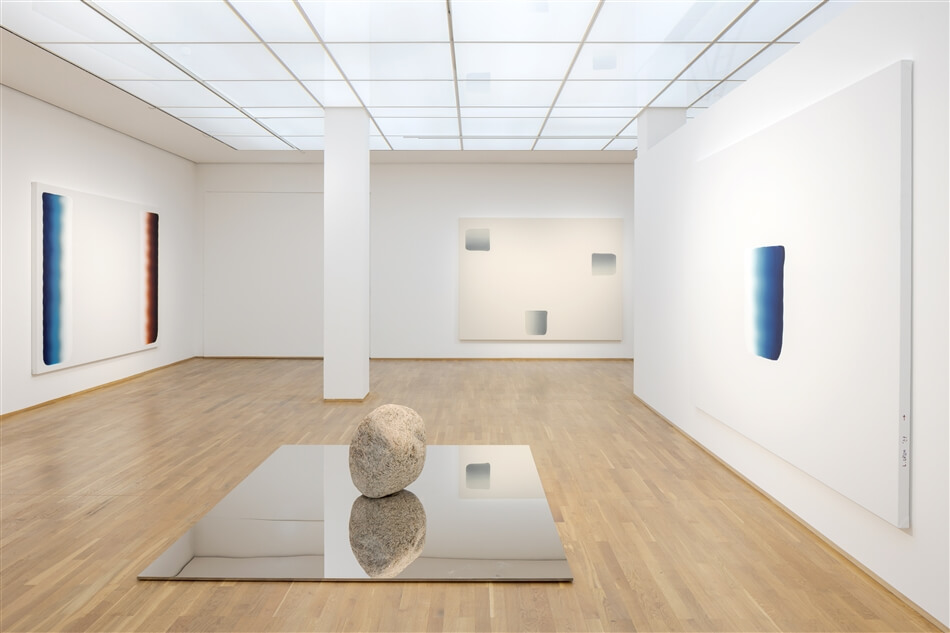
Lee Ufan
Hamburger Bahnhof – Nationalgalerie der Gegenwart Berlin
October 27, 2023 – April 28, 2024
Hamburger Bahnhof presents the first retrospective of the artist and philosopher Lee Ufan in Germany. Lee is one of the most important representatives of the Mono-ha school in Japan and the Dansaekhwamovement in Korea, which developed concurrently with other minimal art movements worldwide. The exhibition features about 60 works spanning six decades of his career. Lee’s decades-long engagement with painting is reflected in an extraordinary highlight: Rembrandt‘s famous “Self-Portrait with Velvet Beret” (1634) from the Berlin Gemäldegalerie will be shown for the first time at Hamburger Bahnhof in a dialogue with Lee’s expansive installation “Relatum – The Narrow Sky Road” (2020/2023). In this way, Lee’s art introduces visitors to the formative art movements of Japan and Korea in the 1970s and provides a new perspective on an icon of Western European art.

The exhibition provides an insight into the work of the Korean artist Lee Ufan (born 1936, lives and works in Kamakura, Japan and Paris, France), almost 50 years after his first exhibition participation at Kunsthalle Düsseldorf. Lee Ufan was born in South Korea during Japanese colonial rule (1910–1945) and moved to Japan in 1956. The retrospective opens with the painting “Fourth Structure A” (1968) which was exhibited in 1968 at the National Museum of Modern Art in Tokyo. Lee’s early paintings were characterized by optical illusions through shapes and fluorescent paint. A turning point in his art was the student protests of 1968: he reacted to these with performative actions in which he dropped a large stone on a glass plate and broke it.

Lee’s philosophical writings coined the term Mono-ha for a group of artists active in Tokyo from 1968 to 1975. Mono-ha is one of the most important art movements of post-war art in Japan. Mono-ha, which translates roughly as “school of things,” rejected traditional notions of art. In their sculptures and installations, the artists combined raw materials such as stones, tree branches or earth with industrial materials such as steel or glass. Instead of being expressions of the artist’s ego, they were concerned with grounding the world as it is.

Lee’s sculpture series “Relatum” has followed this approach since 1968. The Latin term “relatum” refers to the interconnectedness and relation of elements within a system. Since 1968, all of Lee’s sculptural installations have carried the term as their title and embody the precise spatial arrangement of natural and industrial elements.

Lee places materials in relation to each other, to space, as well as to the viewers. In the museum’s garden, the sculpture “Relatum – Memory of Place” (1977) from the collection of the Nationalgalerie can be seen in Berlin for the first time since 1985. For the retrospective at Hamburger Bahnhof, he also adapted the sculpture “Relatum – The Road of Ring” (2023) for the museum garden. Beginning in the mid-1970s, Korean artists of the Dansaekhwa movement explored abstraction and materiality in monochrome painting. Lee’s series “From Point” (from 1973) and “From Line” (from 1978) bear witness to this.

At Hamburger Bahnhof, he has now created a dialogue between his work “Relatum – The Narrow Sky Road” and Rembrandt’s “Self-Portrait with Velvet Beret” (1634) from the Gemäldegalerie Berlin. During the exhibition runtime, an artistic intervention by Lee will be shown in the Rembrandt Hall of the Gemäldegalerie.
more. www.smb.museum


